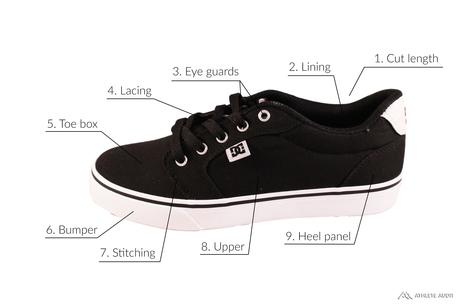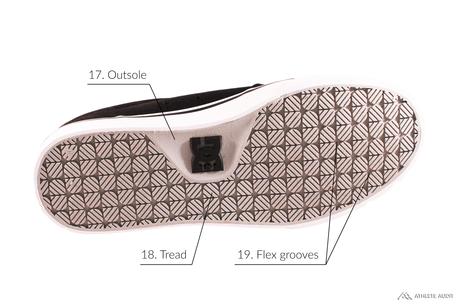Parts of a Skate Shoe



- Cut length – Skate shoes come in low-cuts, mid-tops, or high-tops, each with differing levels of mobility and ankle support
- Lining – The sock-like fabric inside the shoe helps to increase overall comfort
- Eye guards – Metal eye guards help to protect laces from ripping on grip tape
- Lacing – The majority of skate shoes will feature traditional laces, although some may have velcro straps or zippers
- Toe box – A flexible toe box helps to increase range of motion when bending the forefoot
- Bumper – Vulcanized skate shoes will feature a rubber bumper that wraps around the front of the outsole, providing extra durability and grip
- Stitching – Many skate shoes feature double or triple stitches for added durability against grip tape
- Upper – The most popular materials for skate shoe uppers are suede, pig suede, and synthetics. However, there are leather and canvas skate shoes as well but offer less performance
- Heel panel – The piece of fabric that covers the heel area of the shoe
- Tongue – A well-padded tongue helps to increase comfort and protection
- Insole – The footbed of the feet, extremely important for providing shock absorption and comfort. Most skate shoes will have a removable insole to add your own or even an additional one
- Last – Sits beneath the insole, determines the overall shape of the skate shoe
- Midsole – The midsole is located between the insole and outsole. Provides extra cushioning and is often made of EVA or foam
- Heel cushioning – Some skate shoes feature additional heel cushioning for harsh landings
- Heel counter – A rigid plastic insert sits behind the heel and provides structural support and protection
- Collar – A padded collar increases comfort and ankle support
- Outsole – A grippy rubber outsole provides friction against grip tape for staying on your board
- Tread – Most skate shoes feature a herringbone tread pattern for maximum grip
- Flex grooves – Adds flexibility to a skate shoe when bending the forefoot
Learn how to choose skate shoes here




